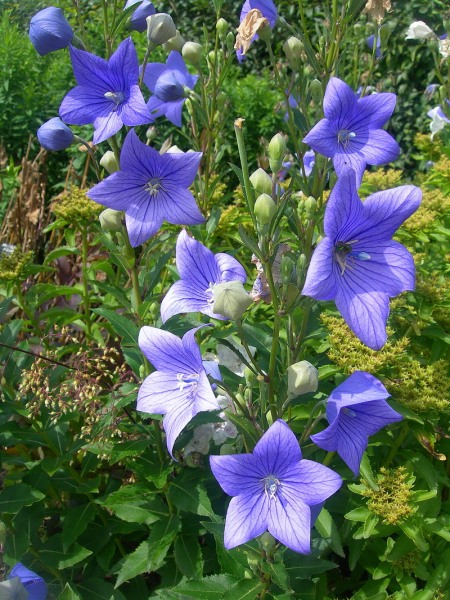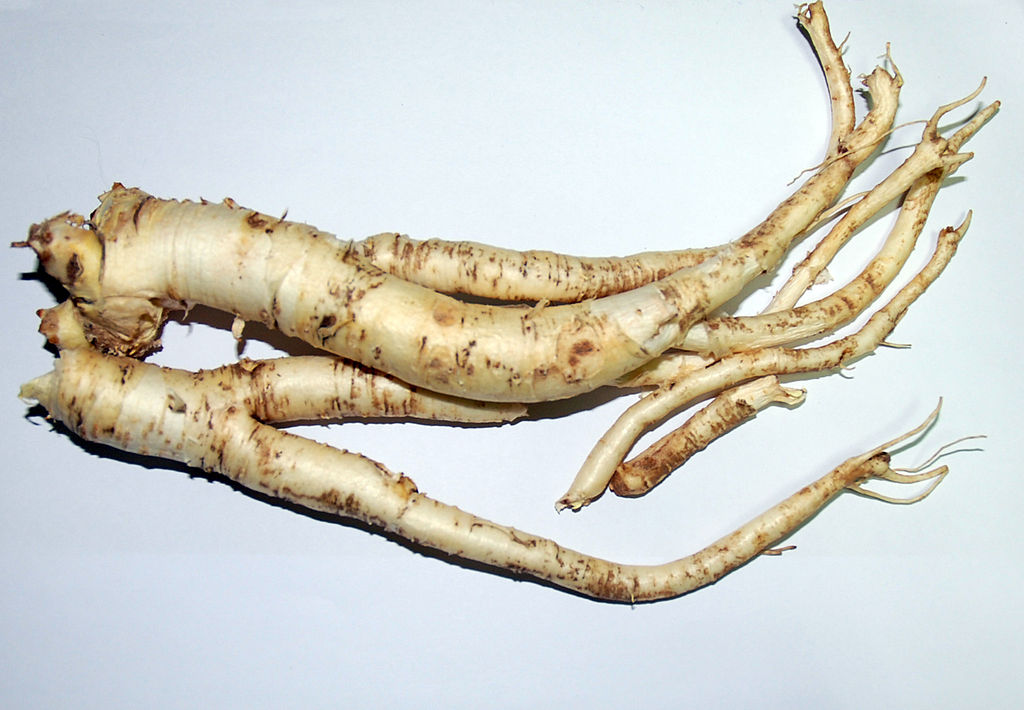 Platycodon
grandiflorus. 桔
梗 Jié gěng
Balloon flower root
Family: Campanulaceae
Platycodon
grandiflorus. 桔
梗 Jié gěng
Balloon flower root
Family: Campanulaceae
PART USED: Root- Collected in Spring and Autumn, dried in sunlight, sliced, and used unprepared.[3]
FUNCTIONS- Directs the effect of other herbs to the upper regions of the body.
GROUP: Antitussive and Expectorant Clearing- Cold Phlegm - Hot Phlegm.[3]
1. Opens up and disperses the Lung Qi.[1,5] Expel, and resolve sputum in Lungs.[5] Resolves phlegm.[1] Stops coughing.[1]
2. Benefit throat.[5] Clears the throat.[1]
3. Promote pus drainage.[1,5] Reduces swelling.[1] Subduing carbuncles.
INDICATIONS
1. Wind Heat exopathogens with symptoms of cough,[5] sore throat, hoarseness, and difficult expectoration, Coughing with copious sputum. Cough due to acute bronchitis, pneumonia or colds.[1]
2. Wind Cold exopathogens marked by cough,[5] and thin white sputum.
3. Pulmonary abscess,[1,2,3] with chest pain, purulent and bloody expectoration and yellow filthy sputum. It is often used with Sore throat. Acute laryngitis.[1] Hematemesis of pus and blood. Expelling pus associated with Lung abscess or throat abscess.[5]
4. Sore throat or loss of voice, espceially in those caused by external Heat, bu also when the condition is due to other factors such as Phlegm Heat or Yin deficiency with Heat signs.[5]
CONTRAINDICATIONS: Hemoptysis.[5] Some traditional sources state that this herb counteracts Gentiana scabra- Long dan cao and Dimocarpus longan- Long yan rou.[5]
PATENT COMBINATIONS
COMBINATIONS
PREPARATIONS: Decoction Roots 3-10 g.[1,2,3,5] Good quality is large, thick, firm, bitter, and white.


 HABITAT: Found growing wild in unreclaimed places
and wasted slopes.
HABITAT: Found growing wild in unreclaimed places
and wasted slopes. DESCRIPTION: Perennial herb. Whole plant contains a milky juice. Roots; fleshy, cylindrical, light yellowish-brown. Stem: erect, singly or multibranched, cylindrical. upper stem leaves alternate, narrowly lanceolate, lower stem leaves 3-4 whorled, ovate, oblong-rounded to ovate-lanceolate, apexes short-acute, bases gradually narrowing, margins sharply serrated. Flowers; in summer, blueish-purple flowers appear singly at terminal styles, or several appear to form racemose inflorescences. Capsule: obovate
References
Inner Path can not take any responsibility for any adverse effects from the use of plants. Always seek advice from a professional before using a plant medicinally.
Constituents
Research
Platycodon grandiflorus - an ethnopharmacological, phytochemical and pharmacological review.
Zhang L, Wang Y, Yang D, Zhang C, Zhang N, Li M, Liu Y.
Abstract
ETHNOPHARMACOLOGICAL RELEVANCE:
Platycodon grandiflorus (Jacq.) A. DC., the sole species in genus Platycodon A. DC. (Campanulaceae) has a long history of use as a traditional herbal medicine for the treatments of cough, phlegm, sore throat, lung abscess, chest pain, dysuria, and dysentery. As a legal medicine and dietary supplement, it is also frequently used as an ingredient in health foods and vegetable dishes. The aim of this review is to provide up-to-date information on the botanical characterization and distribution, ethnopharmacology, phytochemistry, pharmacology, and toxicity of Platycodon grandiflorus based on literature published in recent years. It will build a foundation for further study of the mechanism of action and the development of better therapeutic agents and healthy products from Platycodon grandiflorus.
MATERIAL AND METHODS:
All of the available information on Platycodon grandiflorus was collected via electronic search (using PubMed, SciFinder Scholar, CNKI, TPL (www.theplantlist.org), Google Scholar, Baidu Scholar, and Web of Science).
RESULTS:
A comprehensive analysis of the literature obtained through the above-mentioned sources confirmed that ethno-medical uses of Platycodon grandiflorus have been recorded in China, Japan, Mongolia, and Korea for thousands of years. A phytochemical investigation revealed that this product contains steroidal saponins, flavonoids, polyacetylenes, sterols, phenolics, and other bioactive compounds. Crude extracts and pure compounds isolated from Platycodon grandiflorus exhibited significant anti-inflammatory and immunostimulatory effects. They also showed valuable bioactive effects, such as anti-tumor, anti-oxidant, anti-diabetic, anti-obesity, hepatoprotective and cardiovascular system effects, among others.
CONCLUSIONS:
In light of its long traditional use and the modern phytochemical and pharmacological studies summarized here, Platycodon grandiflorus has been demonstrated to show a strong potential for therapeutic and health-maintaining uses. Both the extracts and chemical components isolated from the plant showed a wide range of biological activities. Thus, more studies on the pharmacological mechanisms of its main active compounds (e.g., platycodin D, D2) need to be conducted. In addition, as one of the most popular traditional herbal medicines, clinical studies of the main therapeutic aspects, toxicity and adverse effects of Platycodon grandiflorus will also undoubtedly be the focus of future investigation.PMID: 25666431 DOI: 10.1016/j.jep.2015.01.052 J Ethnopharmacol. 2015 Apr 22;164:147-61. doi: 10.1016/j.jep.2015.01.052. Epub 2015 Feb 7. ncbi.nlm.nih.gov
Platycodon grandiflorus Root Extract Attenuates Body Fat Mass, Hepatic Steatosis and Insulin Resistance through the Interplay between the Liver and Adipose Tissue.
Kim YJ, Choi JY, Ryu R, Lee J, Cho SJ, Kwon EY, Lee MK, Liu KH, Rina Y, Sung MK, Choi MS.
Abstract
The Platycodon grandiflorus root, a Korean medicinal food, is well known to have beneficial effects on obesity and diabetes. In this study, we demonstrated the metabolic effects of P. grandiflorus root ethanol extract (PGE), which is rich in platycodins, on diet-induced obesity. C57BL/6J mice (four-week-old males) were fed a normal diet (16.58% of kilocalories from fat), high-fat diet (HFD, 60% of kilocalories from fat), and HFD supplemented with 5% (w/w) PGE. In the HFD-fed mice, PGE markedly suppressed the body weight gain and white fat mass to normal control level, with simultaneous increase in the expression of thermogenic genes (such as SIRT1, PPARα, PGC1α, and UCP1), that accompanied changes in fatty acid oxidation (FAO) and energy expenditure. In addition, PGE improved insulin sensitivity through activation of the PPARγ expression, which upregulates adiponectin while decreasing leptin gene expression in adipocytes. Furthermore, PGE improved hepatic steatosis by suppressing hepatic lipogenesis while increasing expression of FAO-associated genes such as PGC1α. PGE normalized body fat and body weight, which is likely associated with the increased energy expenditure and thermogenic gene expression. PGE can protect from HFD-induced insulin resistance, and hepatic steatosis by controlling lipid and glucose metabolism. PMID: 27589792 PMCID: PMC5037519 DOI: 10.3390/nu8090532 Nutrients. 2016 Aug 30;8(9). pii: E532. doi: 10.3390/nu8090532. ncbi.nlm.nih.gov
Anti-inflammatory effects of saponins derived from the roots of Platycodon grandiflorus in lipopolysaccharide‑stimulated BV2 microglial cells.
Jang KJ, Kim HK, Han MH, Oh YN, Yoon HM, Chung YH, Kim GY, Hwang HJ, Kim BW, Choi YH.
Abstract
Radix platycodi is the root of Platycodon grandiflorus A. DC, which has been widely used as a food material and for the treatment of a number of chronic inflammatory diseases in traditional oriental medicine. In this study, the anti‑inflammatory effects of the saponins isolated from radix platycodi (PGS) on the production of inflammatory mediators and cytokines in lipopolysaccharide (LPS)-stimulated BV2 murine microglial cells were examined. We also investigated the effects of PGS on LPS‑induced nuclear factor‑κB (NF-κB) activation and phosphoinositide 3-kinase (PI3K)/AKT and mitogen-activated protein kinase (MAPK) signaling pathways. Following stimulation with LPS, elevated nitric oxide (NO), prostaglandin E2 (PGE2) and pro-inflammatory cytokine production was detected in the BV2 microglial cells. However, PGS significantly inhibited the excessive production of NO, PGE2 and pro‑inflammatory cytokines, including interleukin-1β (IL-1β) and tumor necrosis factor-α (TNF-α) in a concentration-dependent manner without causing any cytotoxic effects. In addition, PGS suppressed NF-κB translocation and inhibited the LPS-induced phosphorylation of AKT and MAPKs. Our results indicate that the inhibitory effect of PGS on LPS-stimulated inflammatory response in BV2 microglial cells is associated with the suppression of NF-κB activation and the PI3K/AKT and MAPK signaling pathways. Therefore, these findings suggest that PGS may be useful in the treatment of neurodegenerative diseases by inhibiting inflammatory responses in activated microglial cells.
PMID: 23563392 DOI: 10.3892/ijmm.2013.1330 Int J Mol Med. 2013 Jun;31(6):1357-66. doi: 10.3892/ijmm.2013.1330. Epub 2013 Apr 4. ncbi.nlm.nih.gov
Platycodon grandiflorus Root Extract Improves Learning and Memory by Enhancing Synaptogenesis in Mice Hippocampus.
Kim JI, Jeon SG, Kim KA, Kim JJ, Song EJ, Jeon Y, Kim E, Lee KB, Kwak JH, Moon M.
Abstract
Platycodon grandiflorus (Jacq.) A.DC. (PG) has long been used as an ingredient of foods and is known to have beneficial effects on cognitive functions as well. The present study examined the effect of each PG extract (PGE) from root, aerial part, and seeds on cognitive functions in mice. Changes in spatial learning and memory using a Y-maze test, and markers of adult hippocampal neurogenesis and synaptogenesis were examined. Moreover, changes in neuritogenesis and activation of the ERK1/2 pathway were investigated. Results indicated that mice administered PGE (root) showed increased spontaneous alternation in the Y-maze test and synaptogenesis in the hippocampus. In addition, PGE (root) and platycodin D, the major bioactive compound from the PG root, significantly stimulated neuritic outgrowth by phosphorylation of the ERK1/2 signaling pathway in vitro. These results indicate that the PGE (root), containing platycodin D, enhances cognitive function through synaptogenesis via activation of the ERK1/2 signaling pathway.
PMID: 28737698 PMCID: PMC5537907 DOI: 10.3390/nu9070794 Nutrients. 2017 Jul 23;9(7). pii: E794. doi: 10.3390/nu9070794. ncbi.nlm.nih.gov
Platycodon grandiflorus alleviates DNCB-induced atopy-like dermatitis in NC/Nga mice.
Park SJ, Lee HA, Kim JW, Lee BS, Kim EJ.
Abstract
OBJECTIVE:
To investigate the therapeutic effect of crude extract from Platycodon grandiflorum (PG) roots on atopic dermatitis (AD)-like skin lesions in NC/Nga mice.
MATERIALS AND METHODS:
To develop atopic dermatitis-like lesions, 200 μl of 0.3% 1-chloro-2, 4-dinitro benzene (DNCB) in acetone/olive oil (3:1) was applied 3 times a week for 2 weeks on the shaved skin of their backs. PG extract was dissolved in saline and orally administrated at concentrations of 300 and 500 mg/kg every day for 2 weeks. The therapeutic effect of PG on AD-like skin lesions was assessed by measuring skin severity scores and epithermal thickness, serum total immunoglobulin (Ig) E, histopathological findings for inflammatory cells including mast cells, macrophage and T cells, and mRNA expression of various cytokines related to the inflammatory and allergic response. The significance of inter-group differences was analyzed using the ANOVA test. Data were considered to be significant when P < 0.05 or P < 0.01. RESULTS:
Oral treatment of PG suppressed AD-like skin lesions according to the assessment of skin severity and epithermal thickness in the DNCB-treated NC/Nga mice. This alleviation was further correlated with a reduction of elevated serum total IgE or cytokine mRNA in the PG-treated group compared with vehicle-treated positive group. In addition, infiltrated inflammatory cells decreased on the skin lesions compared with vehicle-treated group.
CONCLUSION:
These results suggest that PG may have a potential therapeutic effect for AD via the inhibition of both inflammatory and allergic reaction.
PMID: 23087507 PMCID: PMC3469949 DOI: 10.4103/0253-7613.99306 Indian J Pharmacol. 2012 Jul-Aug;44(4):469-74. doi: 10.4103/0253-7613.99306. ncbi.nlm.nih.gov